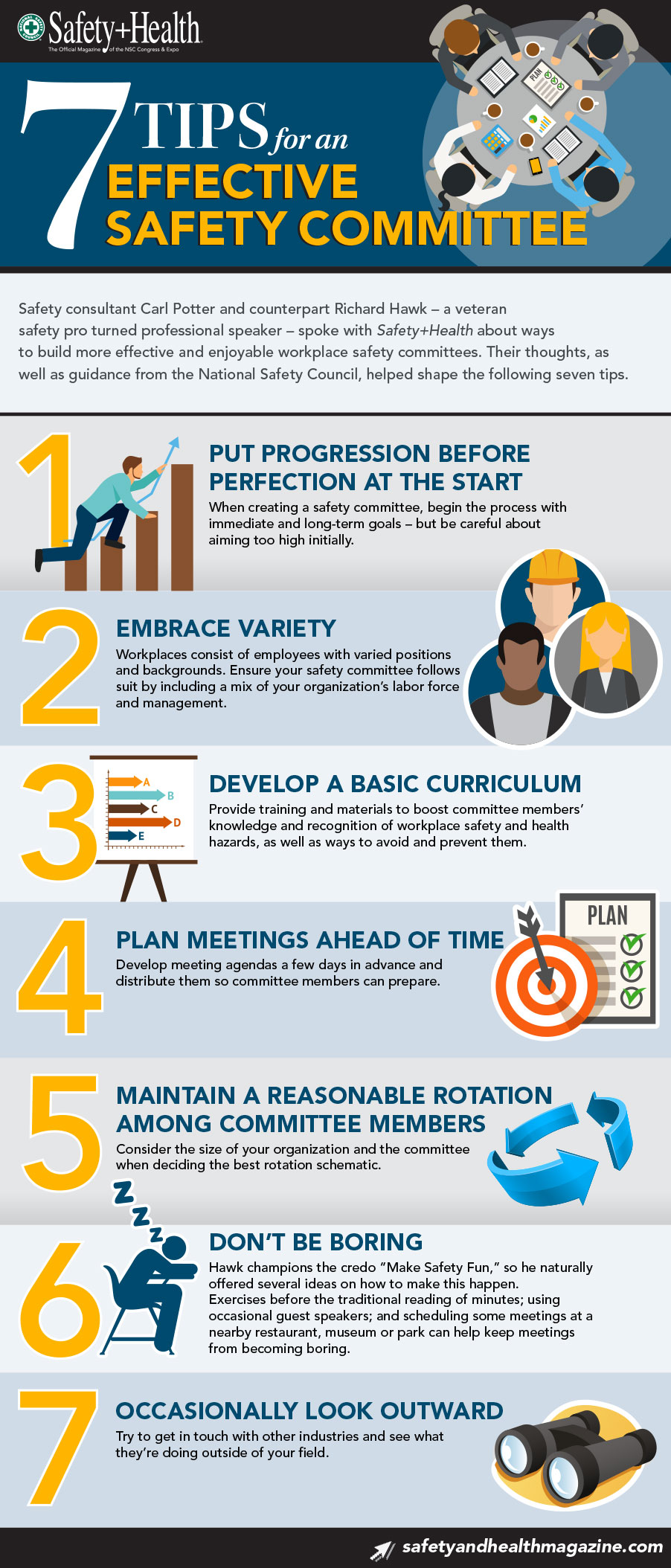7 tips for an effective workplace safety committee

Looking for safety talk ideas? See our Safety Tips section.
Safety consultant Carl Potter once was told about a workplace in which an employee asked for his name to be deliberately drawn from a hat so he could be the new member of the organization’s safety committee.
Although he felt otherwise, the worker planned to feign disgust at the selection when his name was revealed during an assembly. Such irritation simply matched the workplace culture.
“It wasn’t popular to be a member of the safety committee and like being on it,” said Potter, who is based in Tulsa, OK.
Potter and counterpart Richard Hawk – a veteran safety pro turned professional speaker based in Bridgeton, NJ – believe it doesn’t have to be that way. Each spoke with Safety+Health about ways to build more effective and enjoyable workplace safety committees. Their thoughts, as well as guidance from the National Safety Council, helped shape the following seven tips.
Put progression before perfection at the start. When creating a safety committee, begin the process with immediate and long-term goals, but be careful about aiming too high initially.
“What are you going to accomplish?” Potter said. “Is there a measurement that you’re going to have? What can you do to push safety forward just a little bit? Not monumental, not huge, but one thing that you can hang your hat on Dec. 31 and say, ‘This is what our committee accomplished in 2017.’”

Embrace variety. Workplaces consist of employees with varied positions and backgrounds. Ensure your safety committee follows suit by including a mix of your organization’s labor force and management.
“This is not an authority position,” Potter said. “This is a representation.”
Committees should include current or previous safety champions as well. “Make sure you have people who are gung ho about it, because that’s really important when you get it going,” Hawk said.
Develop a basic curriculum. Be prepared to provide training and materials to boost committee members’ knowledge and recognition of workplace safety and health hazards, as well as ways to avoid and prevent them.
Potter noted that numerous safety education resources are available. NSC and other worker safety organizations offer extensive training in a variety of areas, while the OSHA Outreach Training Program includes 10-hour and 30-hour classes.
Plan meetings ahead of time. Develop meeting agendas a few days in advance and distribute them so committee members can prepare. Part of the agenda should include setting a time limit for the entire meeting as well as for each agenda item. Monitor how meetings adhere to these limits.
Hawk also favors having one person serve as the committee’s “conscience.” This person’s duties would include keeping the group focused and ensuring the committee is acting properly, following pre-determined ground rules and treating all members with respect.
Maintain a reasonable rotation among committee members. Ideally, the committee will be made up of volunteers rather than appointed or selected members. That dynamic increases the probability of consistent member investment and energy, Hawk and Potter said.
Consider the size of your organization and the committee when deciding the best rotation schematic. Hawk stressed the importance of a quantity of perspectives and the tendency of groupthink to build on an individual’s idea.
“That’s one thing that happens a lot – people get on a committee and then no one else can get on it,” Hawk said. “So make sure it rotates a lot.”
For most larger companies, Potter suggests a rotation of three years on, two years off.
Don’t be boring. Hawk champions the credo “Make Safety Fun,” so he naturally offered several ideas on how to make this happen.
“It gets to be so boring, like meetings can in general,” Hawk said. “So what can you do to vary it? Make it an agenda item. Talk about what we can do to make these meetings more fun and make them better.”
Suggestions include opening meetings with personal reflections or exercises before the traditional reading of minutes; using occasional guest speakers; and scheduling some meetings at a nearby restaurant, museum or park.
Professional decorum still applies, of course.

Occasionally look outward. “Try to get in touch with other industries and see what they’re doing outside of your field,” Hawk said. “For example, if you’re in construction, oil or gas [industries], reach a hospital and see what their safety committee is doing.
“Just getting your brain thinking differently. That’s exactly what it is. They’re going to have a different mindset and approach than you will. Plus, it’s more interesting for the committee members when they do that kind of stuff. Plus, it’s not hard to do.”
Post a comment to this article
Safety+Health welcomes comments that promote respectful dialogue. Please stay on topic. Comments that contain personal attacks, profanity or abusive language – or those aggressively promoting products or services – will be removed. We reserve the right to determine which comments violate our comment policy. (Anonymous comments are welcome; merely skip the “name” field in the comment box. An email address is required but will not be included with your comment.)

